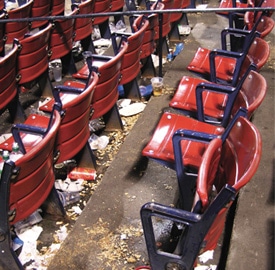The start of the football season is officially here, so we are diving into the whole nine yards of stadium and arena recycling. Stadiums and arenas hold major events including sporting events (football, baseball, hockey, basketball), big-name concerts, and other large functions. It's shocking how much waste is generated in restaurants, bars, souvenir stands, stores, concession stands, and seating areas throughout the facilities. The consistent output of waste makes recycling a great opportunity for stadiums and arenas! Since the start of the football season was a couple of weeks ago, RoadRunner wanted to get involved the best way we know how, so we're going to cover how stadiums and arenas can best recycle and minimize their waste.

High Volumes of Waste
Some stadiums have seating capacity for over 100,000 people and are equipped and large enough to accommodate an entire city. When that many people are together in one place, high volumes of waste is created. According to the EPA, an average college football game produces anywhere from 50 to 100 tons of waste. The large amounts of waste generated at each event means that venues have ample opportunities to create sustainable recovery programs. The good news is most of the materials can be recycled or composted, saving them thousands of dollars in disposal fees and high diversion rates.
Green Game Plan
Establishing recycling programs for each of the materials generated is the best way to maintain their quality. Aluminum cans, and plastic & glass bottles are among the recyclable materials that are generated the most by fans. Commingled recycling captures the value of the containers and keeps them separate from fibrous materials. We recommend that all the bins are placed strategically throughout the stadium in high traffic areas, such as near restrooms, hallways, and concession stands so fans can conveniently access them.
Stadiums and arenas also accumulate a lot of cardboard packaging and mixed paper products in their restaurants, concession stands, and stores. It's best practice to have the staff break down the cardboard and collect it separately from other materials.
To receive fan participation, it's necessary to provide education and signage on each of the containers so fans know how and what to recycle. This will increase recycling rates and avoid contamination.
Opportunities to collect waste also exist outside of the stadium in parking lots from pre-event tailgating. Upon entering the Pittsburgh Steelers Heinz Field's parking lots, fans are given trash and recycling bags and are expected to appropriately dispose of their waste.
 |
Additionally, the EPA suggests that a post-event bleacher clean up is one of the most effective ways to recover recyclable materials because most food and beverages are consumed by fans in their seats. Stadium staff or volunteers can collect the left-behind recyclables and trash separately in the seating area to increase recycling. |
Stadiums & Sustainability MVP's
Stadiums all over the country are being recognized for their recycling and waste optimization programs. Last year's Super Bowl LII teamed up with Rush2Recycle and diverted over 90% of game-day related waste from landfill. They were able to recover 63 tons of waste through recycling and composting. 29% of the total waste was recovered through composting and 62% was recycled or donated.
The Philadelphia Eagles have changed the recycling game by diverting 99% of their stadium waste from landfill. The Eagles are reported to produce 850 tons of waste each year but have diverted nearly all of it through green energy procurement, energy conservation, recycling and composting.
Ohio Stadium is the largest stadium in the U.S. that is able to continuously divert 90% or more of their game-day waste from landfill. The stadium has attributed most of the success of their waste diversion program to separating their materials by stream. An article from bizjournal explains, "nearly 96 tons of recycling and compost materials were produced this season, with only 4.5 tons of trash being sent to landfills."
Stadiums and arenas have the opportunity to greatly impact the environment though waste reduction, composting, and recycling. They also have the ability to influence fans to make smarter recycling decisions by promoting efficient recycling practices and bringing awareness to the topic. If you're interested in learning more about how RoadRunner can help your stadium or arena recycle more of its materials, get in touch with us here.